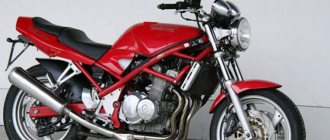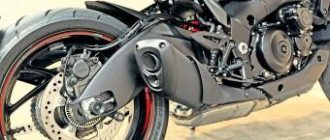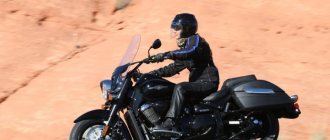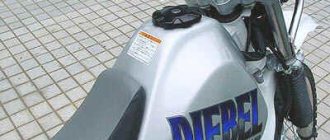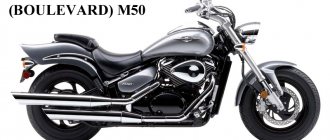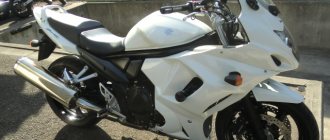| Suzuki GSX-R400 (1984) | Suzuki GSX-R400 (1986) | Suzuki GSX-R400+SP (1987) |
| Suzuki GSX-R400R (1988-1989) | Suzuki GSX-R400R SP (1988-1989) | Suzuki GSX-R400R +SP (1990-1995) |
Suzuki GSX-R 400 sports motorcycle model
appeared in 1984 (
GK71B
). The model of that time featured an aluminum frame and a powerful 59 hp engine. and a record dry weight of 152 kg. The model had a rather archaic appearance (by modern standards), and is now practically not found on the market.
The first major changes to the motorcycle occurred in 1986 (generation GK71F
). The model received a new appearance with a rectangular headlight, a new exhaust system, new brake discs and a new generation of aluminum frame. The wheelbase was shorter and the power-to-weight ratio was increased to 0.39 hp. per 1 kg of weight. The engine receives a proprietary cooling system using a combination of liquid, air and oil (SATCS - Suzuki advanced three-way cooling system).
In 1987, the generation remained the same - GK71F. However, the model has changed again. The Suzuki GSX-R 400 has returned to dual round headlights (the previous rectangular design was in low demand). The exhaust system, calipers, and wheel sizes have also been updated. A “track” modification, SP (Sports Production), appeared, which was distinguished by a sticker on the plastic, a gear ratio in the gearbox, additional adjustment of the suspension rebound and a rear shock absorber with a remote reservoir.
1988 was marked by another serious restyling of the Suzuki GSX-R400 ( GK73A
).
The model received a more modern design, a new exhaust system, a new generation of aluminum frame, new 4-piston Tokico calipers, a new curved radiator and new carburetors. In 1989, the letter R
- Suzuki GSX-R400R.
In 1990, the model underwent its last major restyling (generation GK76A
). New look, new headlight design, inverted forks, new aluminum frame, new 4-into-1 exhaust.
In 1993, due to an update to Japanese legislation, the maximum power of the Suzuki GSX-R400 was reduced to 53 hp, and 1995 was the last year of production of the model.
The Suzuki GSX-R400 engine was subsequently installed on such models as the Suzuki GSF400 Bandit and Suzuki RF400.
The main competitors of the Suzuki GSX-R400 in the class:
- Honda CBR400RR
- Kawasaki ZXR400
- Honda VFR400
- Yamaha FZR400RR
Brief history of the model
- 1984 - start of production and sales of the model.
Model
: Suzuki GSX-R400 (Japan).
Factory designation
: GSX-R400E.
- 1986 - restyling of the model.
Model
: Suzuki GSX-R400 (Japan).
Factory designation
: GSX-R400G.
- 1987 - restyling of the model. The appearance of the SP modification.
Model
: Suzuki GSX-R400 + SP (Japan).
Factory designation
: GSX-R400H.
- 1988 - restyling of the model.
Model
: Suzuki GSX-R400 + SP (Japan).
Factory designation
: GSX-R400J.
- 1989 - no significant changes. The letter R is added to the model name.
Model
: Suzuki GSX-R400R + SP (Japan).
Factory designation
: GSX-R400RK.
- 1990 - restyling of the model.
Model
: Suzuki GSX-R400R + SP (Japan).
Factory designation
: GSX-R400RL.
- 1991 - no significant changes.
Model
: Suzuki GSX-R400R + SP (Japan).
Factory designation
: GSX-R400RM.
- 1992 - no significant changes.
Model
: Suzuki GSX-R400R + SP (Japan).
Factory designation
: GSX-R400RN.
- 1993 - no significant changes.
Model
: Suzuki GSX-R400R + SP (Japan).
Factory designation
: GSX-R400RP.
- 1994 - no significant changes.
Model
: Suzuki GSX-R400R + SP (Japan).
Factory designation
: GSX-R400RR.
- 1995 - no significant changes.
Model
: Suzuki GSX-R400R + SP (Japan).
Factory designation
: GSX-R400RS.
There is no shame in being average. The fact that many of us are average is neither good nor bad. It just happened this way: not everyone is destined to be born giant heroes and ride a motorcycle from the cradle. Then why do we, the Russian “average”, dream more and more about “liters”, at least about “six hundred”, and consider everything “lower” to suck? To one day hear: “This hat doesn’t suit Senka...”? But “The main thing is that the suit fits”... And among the “four hundred” there are still some cool “suits”! These, for example. I rented the Suzuki GSX-R400R and Kawasaki ZX-4F3 for a week - just to “get in” and understand what I’m dealing with. Having arrived at the motorcycle dealership, I couldn’t resist and jumped into the GSX saddle like a bullet. I waited and felt how the blood in my veins warmed up along with the engine. The eyes are focused on the tachometer, and the ears, getting used to the sounds, have long been controlling the engine’s response to “pickup”. I listen and understand that this is how a real racing engine should work. Start! They only saw me!.. I know: for the next two days, I’m not myself, I’ll just run around from morning to late - either around the city, or specially going out to see friends outside the city. Or I’ll shoot with one of them behind my back. And you also need to be on time for the track. Well, the motorcycle is almost a racing one!.. I decided: first, out of the city, I’ll get used to the motorcycle a little. And it’s quieter outside the metropolis. While driving along the inner-city highway, I had to work mainly in second and third gears; the revs did not drop below 6000. Maneuvering the GSX in a dense stream of cars is easy and pleasant: cars for me are like flags for slalom skiers (it’s a pity that they don’t bend)... And the speed keeps growing and growing, but for some reason I want to go faster and faster... And so that no one dared “across”! The engine works surprisingly easily and as if playfully, as if warming up for real speeds, which I can only guess about. I managed to spin the engine up to 9000 a couple of times, but again and again I ran into some kind of “slow speed” - and again I wait, choosing a situation for a breakthrough. “Jixer” did not even give reason to think that somewhere in its depths there was a limit to its speed capabilities. However, I understand: even here, on the best of the capital’s highways, trying to realize the full potential of a motorcycle is stupid and unsafe. Ring road. I accelerate in third, turn on fourth, speed 140. More acceleration... I change lanes to the far left and... again I run into a slow-moving vehicle. This time - a brand new tuned “ten” with a developed rear wing. I flash my headlights and ask you to give in “in an amicable way.” But in the salon there is some “cupcake” with his girlfriend, she looks around with a malicious smile and observes, what am I going to do? Have you decided to play? Well, let's... I change lanes into our “motorcycle” lane - the one that is very close to the concrete bumpers and only 80 cm wide. I didn’t expect “Cupcake” - I rushed past him in a place where, in his opinion, no one could ever drive, and at such a speed. He jumped away as if scalded, frightening, in turn, those who were riding to his right... It’s not good, of course, but “dummies” need to be taught: what is Caesar’s is what is Caesar’s, and those born to crawl should not pretend to be an eagle. And I think to myself: well done, “jixer”! You have to rush like that in third! I would like to calm down and relax, but I don’t have time - I turned onto the Riga highway. And here it’s as if someone is pushing - just hold on! Dear Mom, I’ll turn it all the way up. There is an open straight ahead - this is where I will find out what my “athlete” is capable of. I start at 30 km/h in second gear and then, having gone through all of them, in sixth I reach the “maximum speed”, which is 180 km/h. I repeat the “exercise” several more times. But now I have maximum control over the “events” on the tachometer: I want to understand how the engine torque develops and to what speed it spins up - then I’ll compare the sensations with the characteristics given by the instruments on the power stand. However, I’m already a little tired, and I’m also hungry “not like a child” - it’s time to take a break. And at the same time analyze the experience. I stopped at the first cafe I came across. While I was waiting for the order, there was time to calmly and thoroughly examine the motorcycle from the outside. The dimensions are modest, the sharp frontal fairing is proportionally small, the low and swift silhouette - all this shapes the landing. This “four hundred” has to be placed compactly, even, I would say, tightly, with a strong tilt forward. Because of this, the muscles of the arms and neck practically do not rest; they are constantly tense. Especially when you slow down. The high front pegs forced me to hug the fuel tank tightly with my knees, and eventually I was forced into a fetal position. Even for me, these landing dimensions (I am 164 cm tall) seemed to be extremely acceptable here. This means that anyone who is larger will feel cramped and uncomfortable behind the wheel of the GSX. “Communication” with the devices was easy. When I achieved maximum acceleration or flew at top speed, I always managed to “scan” their readings in a split second (I’m not talking about the merits of my reaction, but about the merits of the “tidy”). It also has an engine temperature sensor - an absolutely necessary thing for such a nimble and high-revving engine: if it is there, it’s simply impossible not to look at it... By the way, speaking of instruments, I remembered the situation with that couple on the tuned “ten”: when I decided to overtake them, my gaze noticed the readings on the speedometer and tachometer. The speed was about 150 km/h, revolutions were 11,500 per minute. "Jixer" confidently rushed forward. Fantastic! But for “400” such jerks at such speeds are normal. The aerodynamic properties of this “sport” are unique. If you ride in the “area” of 150-160 km/h, the wind does not force you, as on other sportbikes, to “grow” into the gas tank. On the contrary, the driver can make good use of the “windage” in such driving modes; the wind supports the pilot’s body quite well. For those who are going to use the Jixer in “civilian” rather than sports mode, this will help keep the muscles “fresh”... The food arrived, and I got a little distracted. I looked around: the cafe’s visitors, no less than mine, were “licking their eyes” at the motorcycle, and kept pointing their fingers at it. So, I liked it! It's nice, you know! I didn’t eat long - there were many glorious things ahead. I quickly paid and wandered to the device. While I was putting the helmet on, a young couple with a child came up and asked permission to take a photo next to the motorcycle. They said that they were going home to a village near Volokolamsk: “We’ve never seen anything like this ‘live’.” In their village there are only Minski and Ural cars. While the engine was warming up, I studied the “anatomy” of the car. Front and rear suspension with preload adjustments. They are short travel, so they are clearly designed for ideal road surfaces, but that's all for racing. In the meantime, I took out the caliper I had stored for such a case, and was not too lazy - I measured the working stroke of the front one. Why him first? Yes, because a few minutes before the stop I flew into a decent hole, and the suspension worked to capacity. That's right: 60 mm. God knows what, but you have to understand that this is not a special order for Russia. But there are also plenty of advantages - the suspension is adjustable, energy-intensive, its travel is enough to “process” a “high-speed” road surface with all sorts of seams or other minor defects. Another thought: the small angle of the fork and the modest base of the motorcycle turn the device into a creation that is very, very susceptible to the slightest movements of the pilot. But, I thought, I won’t rush to a conclusion whether this is good or bad: an assessment for this indicator can only be given after a test on the track - in the place where, in fact, the sportbike should live. After some time, I was already accelerating and slowing down on a swerving, typical for the Moscow region, two-lane suburban highway. It’s not bad that I was brought here - here I can test the engine under various loads, but in the zone of low and medium crankshaft speeds. I switch to third, reduce the speed to the minimum stable, and then go into acceleration - sometimes more dynamic, sometimes less... Until it became clear in what modes the engine should be operated, in other words, in what speed range the “comfort zone” occurs » its operation (sometimes also called working). ...This was to be expected: when at low speeds I opened the gas all the way and, it seemed, a jerk should come, the engine seemed to temporarily refuse to understand me. However, after a moment the tachometer needle again reaches the 6000 mark, and the motorcycle, as if nothing had happened, rushes along pleasantly and easily. While maneuvering on a winding road, I begin to feel that the car is light, both in weight and in handling. This motivates me to perform feats: oh, I wish I could drive her at top speeds with a cascade of turns and shifting the body left and right - after all, she’s a tomboy, but she’s obedient! ... But the tomboy won’t warm me up: this is not some kind of Ural with an opposed stove and not an Intruder with “towers” of cylinders. Well, okay, I’ll be patient... I got stuck in a suburban “traffic jam”: I was forced to spend 40 minutes at a crossing equipped with barrier shields rising “out of the ground” - you can’t drive over them, you can’t roll over them. While I was standing there, I remembered a joke: why didn’t the Germans reach Moscow during the Great Patriotic War? Because the crossing was closed... Probably about the same one... It got completely dark, and I had to move with the headlights on. I was pleased with the light, as well as with the instrument lighting - it has a pleasant green tint. When I pushed the GSX into the garage where the car “lives”, I once again paid tribute to the modest dimensions of the “Gixer”. Not only me, but also other motorcyclists and car owners, I am sure, will think about the same thing - for many, the question of where and how to store a motorcycle is not an idle one... I jumped up early in the morning and agreed with a friend that I would drop him off at work in the center. We rode calmly, and when we said goodbye, he said with a sour expression that this motorcycle was created exclusively for one rider - the pilot. He, the passenger, did not like the trip. While I was getting to Khodynka (more precisely, to what was left of it after the “ring” route was razed), I felt the air warming up. “And that means asphalt,” I thought happily. There was a lot to be done... I drove the engine in real racing mode - and marveled at how easily it spins up to 14,000-odd rpm, while furiously storming the 12,500 mark stated in the passport. What is important: even under such loads - be it acceleration or engine braking - the gearbox works smoothly and flawlessly. And softly. Changing speeds in corners is pleasant and safe, not like, say, on “fisers” (that is, FZR) - they are a little scary. I adjusted the suspension and was able to shift the motorcycle even more actively on turns. Sports bikers will understand me: the fast response of the suspension provides the tires with stable grip on the road surface. What else does a “racing” motorcycle need if it already has an excellent engine?! That's right - reliable brakes. The first thing I want to note is that in the front brake you can adjust the drive lever to its original position. This is a definite plus; it gives anyone who finds themselves behind the wheel the opportunity to customize the brakes to suit themselves. Next - about the brake mechanism. The good thing about it is that you can precisely measure the braking force with it, which means you always keep the situation under control. The fact that my feeling of comfort was not wrong was confirmed after measuring the braking distance when I used only the front mechanism. The result is 14.9 meters. Bravo, GSX! But here’s the trick: no matter how hard I worked, pressing on both brake levers during combined braking, I still couldn’t shorten the braking distance. The result is the same - 14.9 meters. This means that such a high indicator with one front one is due, first of all, to its good workload. All “ring” motorcycles “sin” with this. You yourself probably already realized that you can’t rely on high deceleration efficiency just due to the rear brake alone: the result is 38 meters. Alas... And this is with the motorcycle weighing only 167 kg. And again, I’m in no hurry to attach an evaluative label - I’ll try to find out the truth, if not in an argument, then in comparison. And he went to “exchange” his favorite “tomboy” GSX for another – ZX-4. The one from Kawasaki. “Hello, “green”! Let's see what and where you have and how it works. The “tidy” is very good; it is made in a single unit and is complemented by a fuel sensor. Whatever you say, it’s a useful thing; it often helps out a pilot who is carried away by speed. I know it from myself. Instruments (including the speedometer, tachometer and temperature gauge) are easy to read - without eye strain. I think there shouldn’t be any problems with “reading” on the road. I start it... I again use the warm-up pause to deepen the acquaintance. So, sir... Everything seems to be in order with the electrics... Here is the hazard warning button, here is a small lever for pulsating the high beam headlights. Wonderful... What is this? In the “line” of control lamps there is another one, the purpose of which I cannot understand. I can’t yet, but I’ll definitely figure it out later... Someone called - I raised my eyes and looked in the rearview mirror. No, it wasn't my name. But this glance was enough to draw attention to how vast the area of the mirrors is. “Not like the GSX,” I compared, “which means it will be much easier to navigate city traffic with these.” I wanted to customize the clutch and front brake levers to suit myself, but, to my surprise, I discovered that the brake lever on this Kava is unadjustable. It’s a pity, you get used to good things quickly and you already count on the same option as a matter of course. For example, the same “tomboy” - “Susa” has as many as four initial positions. I settled into the saddle... It seemed more free to sit here. But I didn’t trust my feelings - I reached for the tools and started measuring. There was good reason to doubt it - the landing dimensions turned out to be less tight than those of the Susa. (The handlebars are higher (by 10 cm) and the tank is shorter (by 3 cm).) That's why the ZX-4 is more comfortable to sit on. And not just me. I gave a ride to a gas station from a motorcycle dealership employee. There was a 20-liter canister between us, but he felt quite free from behind. Along the way, I tried to persuade him: think about safety, hold on tight - he didn’t even react... But I’m talking about something else: such a number would not have worked with the GSX. Remember, my friend, whom I gave a ride to work, felt bad even without a canister. It so happened that I “drove around” the motorcycle later, after I took it to bench tests: the comparisons went according to the opposite scenario. Which is also interesting. After a couple of hours, I already had a complete layout for the “green” on paper. With him I went wherever my eyes led me. Moving around the city, I noticed that the “frog” (that’s what I will now call the “green one”) reacts with the greatest enthusiasm to the “gas” in the low and medium speed zone. Stable engine operation begins at 4000 rpm. True, the engine operates noticeably rougher - it has more “harsh” reactions to the pilot’s actions, especially when engine braking. And in terms of speed of promotion, it feels inferior to the “jixer”. About the gearbox. Finding neutral on the green is just as difficult as on the GSX. You have to work with the gear shift foot just as often. Thanks to a less “tight” fit than on a “tomboy”, as well as a more elastic engine, it is very comfortable to move on it and at lower speeds: the motorcycle maneuvers easily, and knocking it off a straight course is much more difficult than a “tomboy”, especially at maximum speed. The suspensions exactly follow the profile of the road surface... All this gives me a feeling of security and complete trust in the “frog”.
With these thoughts in the evening, I again pushed the motorcycle into my cramped garage. And I didn’t immediately notice any special differences with Suzuki (I’m talking about the dimensions of the device). Except that Kawa is taller. I measured it and realized it was a little over 12 centimeters. They were the ones who got in the way: the windshield came up against the side mirror of my car. But GSX passed under it. The next morning it was raining, it was unpleasant, but we had to go. It was then that I thanked the creators for these “twelve-odd”. In addition, the Kawa’s engine is warmer, which gives the pilot a feeling of better protection from bad weather. Is it really that important? When you freeze, you involuntarily pay attention to such seemingly trifles. A slippery surface is fraught with danger, so in wet weather a normal racer begins to slam on the brakes. The Kawa has a larger rear brake disc diameter than the GSX and is better loaded at the rear wheel. And although there is practically no difference in the results of measuring braking distances with the Suzuki, it is easier to work with the rear brakes on it. Check out the table for the measurement data. As for the front ones, they are much worse than the GSX. But the loss is only according to formal indicators. I will tell you about my feelings, which may seem ridiculous. Despite the fact that the brake drive lever is not adjustable to its original position, the lever travel is sufficient, and the deceleration is always adequate to the force on the lever. If we continue to compare the fundamental parameters, I will draw your attention to the fact that in terms of weight (the “frog” is as much as 15 kg lighter than the “tomboy”) and power consumption, the ZX-4 is generally ahead of all its competitors, including such famous ones as the Yamaha FZR400, Honda CBR400 or VFR400. Wow! The designers achieved this thanks to the massive use of aluminum alloy in the chassis, frame and swingarm. This helps a lot in “working” with the motorcycle, especially on the track. Laying down the ZX-4, as well as keeping it in a turn, is quite simple. The advantage of the chassis is that it forgives you many mistakes in piloting that a “tomboy” will not make. For example, significant vibrations of your body in a turn. True, the Kawa engine spins much less willingly, and there is no point in pushing it past 12,000 rpm. At the “tops” he “lives” somewhat apathetically, and does not provoke the pilot to make himself squeal like a pig. The gearbox works smoothly and smoothly in any mode, including racing mode. Like the clutch mechanism, it is almost impossible to overheat. But you can only adjust the suspension halfway - the front one has no adjustments. But the rear, unlike many other motorcycles, has a stepless adjustment mechanism for spring preload, thanks to which it can be more accurately adjusted to a particular type of surface, load weight, etc. It is also important that the ZX-4 has suspensions with large working stroke. This definitely saves the driver's energy. …Four days flew by behind the wheel of two beautiful cars.
What ratings can I give? Suzuki is a racing machine with amazing reactions to the pilot’s actions. The high sensitivity of the control mechanisms allows the pilot to concentrate on what is most important to him (and the main thing for which this motorcycle was created) - desperately fight for victory. At the same time, the GSX places high demands on your driving skills and requires solid sporting skills. Without them, riding a “tomboy” will turn into a rather painful and boring event. In this sporting sense, the ZX-4 is much more forgiving; it is more convenient to operate it in “civilian” modes. And simpler: it has a significant “road” component, as well as better directional stability than the Suzuki when driving at maximum speeds, and this definitely does it credit. Now try to remember everything that has been said, summarize - and answer yourself: can the capabilities and “abilities” of our “four hundred” suggest that this is “just a semi-motorcycle” in comparison with those with larger engines? I categorically protest against such a statement.
Source: https://www.motodom.ua/mst/21-gsx-r400r.html
Specifications
Technical characteristics of Suzuki GSX-R 400:
| Model | Suzuki GSX-R400 |
| Motorcycle type | sports |
| Year of issue | 1984-1995 |
| Frame | aluminum |
| engine's type | 4-cylinder, 4-stroke, in-line |
| Working volume | 398 cm³ |
| Bore/Stroke | 53.0 x 45.2 mm – Suzuki GSX-R400 (1984) 56.0 x 40.4 mm – Suzuki GSX-R400 (1986-1995) |
| Compression ratio | 11.3:1 – Suzuki GSX-R400 (1984) 12.0:1 – Suzuki GSX-R400 (1986-1995) |
| Cooling | liquid |
| Number of valves per cylinder | DOHC, 4 valves per cylinder |
| Fuel supply system | Carburetor, 4x Mikuni BDST33 - GSX-R400 (1990-1995) |
| Ignition type | transistor |
| Maximum power | 59.0 hp (43.4 kW) at 11000 rpm – GSX-R400 (1984) 59.0 hp (43.4 kW) at 12000 rpm – GSX-R400 (1986-1989) 59.0 hp (43.4 kW) at 12500 rpm – GSX-R400 (1990-1992) 53.0 hp (39.0 kW) at 12000 rpm - GSX-R400 (1993-1995) |
| Maximum torque | 39.0 Nm (4.0 kg*m) at 9000 rpm – GSX-R400 (1984) 37.0 Nm (3.8 kg*m) at 10500 rpm – GSX-R400 (1986-1989) 39.0 Nm (4.0 kg*m) at 10,000 rpm – GSX-R400 (1990-1992) 36.0 Nm (3.7 kg*m) at 10,000 rpm – GSX-R400 (1993-1995) |
| Clutch | Multi-disc in oil bath, cable drive |
| Transmission | 6-speed |
| type of drive | chain |
| Front tire size | 100/90-16 – Suzuki GSX-R400 (1984) 110/80-17 – Suzuki GSX-R400 (1986) 110/70R-17 – Suzuki GSX-R400 (1987-1988) 120/60R-17 – Suzuki GSX-R400 (1989-1995) |
| Rear tire size | 110/90-18 – Suzuki GSX-R400 (1984) 140/80-17 – Suzuki GSX-R400 (1986) 140/60R-18 – Suzuki GSX-R400 (1987-1988) 150/60R-17 – Suzuki GSX-R400 (1989) 160/60R-17 – Suzuki GSX-R400 (1990-1995) |
| Front brakes | 2 disc, 2 piston calipers – GSX-R400 (1984-1987) 2 disc, 4 piston calipers – GSX-R400 (1988-1995) |
| Rear brakes | 1 disc, 220 mm, 1-piston caliper |
| Front suspension | Telescopic fork – Suzuki GSX-R400 (1984-1989) Telescopic fork (+ adjustable rebound) – Suzuki GSX-R400 SP (1987-1989) Inverted fork (+ adjustable rebound - SP) – Suzuki GSX-R400 (1990-1995) |
| Rear suspension | Pendulum with monoshock absorber (adjustable) |
| Motorcycle length | 2090 mm – Suzuki GSX-R400 (1984) 2055 mm – Suzuki GSX-R400 (1986) 2050 mm – Suzuki GSX-R400 (1987) 1995 mm – Suzuki GSX-R400 (1988-1995) |
| Motorcycle width | 710 mm – Suzuki GSX-R400 (1984, 1990-1995) 680 mm – Suzuki GSX-R400 (1986-1987) 695 mm – Suzuki GSX-R400 (1988-1989) |
| Motorcycle height | 1185 mm – Suzuki GSX-R400 (1984) 1155 mm – Suzuki GSX-R400 (1986) 1125 mm – Suzuki GSX-R400 (1987) 1110 mm – Suzuki GSX-R400 (1988-1989) 1060 mm – Suzuki GSX-R400 (1990-1995) |
| Wheelbase | 1425 mm – Suzuki GSX-R400 (1984) 1400 mm – Suzuki GSX-R400 (1986) 1405 mm – Suzuki GSX-R400 (1987) 1375 mm – Suzuki GSX-R400 (1988-1995) |
| Seat height | |
| Minimum ground clearance (clearance) | 135 mm – Suzuki GSX-R400 (1984) |
| Acceleration 0-100 km/h (0-60 mph) | 4.5 sec. |
| Maximum speed | 190 km/h |
| Gas tank capacity | 18.0 l – Suzuki GSX-R400 (1984) 16.0 l – Suzuki GSX-R400 (1988-1995) |
| Motorcycle weight (dry) | 152 kg – Suzuki GSX-R400 (1984) 153 kg – Suzuki GSX-R400 (1986-1987) 160 kg – Suzuki GSX-R400 (1988) 162 kg – Suzuki GSX-R400 (1989) 167 kg – Suzuki GSX-R400 (1990-1992) 169 kg – Suzuki GSX-R400 (1993-1995) |
Review of the Suzuki GSX-R 400 motorcycle
Suzuki GSX-R400(1)
Suzuki GSX-R400(2)
Suzuki GSX-R400
Suzuki GSX-R400R (1988-1989)
Suzuki GSX-R 400 sports motorcycle model
appeared in 1984 (
GK71B
). The model of that time featured an aluminum frame and a powerful 59 hp engine. and a record dry weight of 152 kg. The model had a rather archaic appearance (by modern standards), and is now practically not found on the market.
The first major changes to the motorcycle occurred in 1986 (generation GK71F
). The model received a new appearance with a rectangular headlight, a new exhaust system, new brake discs and a new generation of aluminum frame. The wheelbase was shorter and the power-to-weight ratio was increased to 0.39 hp. per 1 kg of weight. The engine receives a proprietary cooling system using a combination of liquid, air and oil (SATCS - Suzuki advanced three-way cooling system).
The first major changes to the motorcycle occurred in 1986 (generation GK71F
). The model received a new appearance with a rectangular headlight, a new exhaust system, new brake discs and a new generation of aluminum frame. The wheelbase was shorter and the power-to-weight ratio was increased to 0.39 hp. per 1 kg of weight. The engine receives a proprietary cooling system using a combination of liquid, air and oil (SATCS - Suzuki advanced three-way cooling system).
In 1987, the generation remained the same - GK71F. However, the model has changed again. The Suzuki GSX-R 400 has returned to dual round headlights (the previous rectangular design was in low demand). The exhaust system, calipers, and wheel sizes have also been updated. A “track” modification, SP (Sports Production), appeared, which was distinguished by a sticker on the plastic, a gear ratio in the gearbox, additional adjustment of the suspension rebound and a rear shock absorber with a remote reservoir.
1988 was marked by another serious restyling of the Suzuki GSX-R400 ( GK73A
).
The model received a more modern design, a new exhaust system, a new generation of aluminum frame, new 4-piston Tokico calipers, a new curved radiator and new carburetors. In 1989, the letter R
-
Suzuki GSX-R400R .
In 1990, the model underwent its last major restyling (generation GK76A
). New look, new headlight design, inverted forks, new aluminum frame, new 4-into-1 exhaust.
In 1993, due to an update to Japanese legislation, the maximum power of the Suzuki GSX-R400 was reduced to 53 hp, and 1995 was the last year of production of the model.
Suzuki GSX-R400 engine was subsequently installed on models such as the Suzuki GSF400 Bandit and Suzuki RF400 .
The main competitors of the Suzuki GSX-R400 in the class:
- Honda CBR 400RR
- Kawasaki ZXR 400
- Honda VFR 400
- Yamaha FZR 400RR
Reviews
Reviews about Suzuki GSX-R 400:
Expand Collapse
I've been driving it for the 3rd season now, only changing consumables. I changed the battery almost immediately after purchase, but it turned out to be dead from the previous owner. I cleaned the carbs at the end of the 2nd season. At first it was scary to go there because I didn’t know, but then, with the help of a friend, I figured it out. It turned out to be as simple as shelling pears!
In general, the mot is excellent! If you have a head on your shoulders, you can sit down and ride! He gives you the pleasure of having your pants full! + Since childhood, I adored the sound of passing motos, and this one has an excellent exhaust, it brings me to complete ecstasy.
In short, I think that it’s not worth looking at 250s at all! This is a waste of money and time, anyway, after riding for 2-3 weeks you will want more! But on the 400k, after all, you won’t be able to get off without experience for 2-3 years! Especially with such a daring one as the jixer)))) and the landing is excellent and the explosions of the jixer are funny when necessary! In general, I’m glad that I started my motorcycle journey with this model!
The motorcycle was bought from a friend, but in the end I regretted buying this motorcycle. Even though the motorcycle was born in 1995, there were minor breakdowns. The motorcycle was problematic, namely: a rusty tank, dead carbs, oil waste, running out of liners, oil seals. I didn’t drive it for long because it was being repaired for most of the time. The conclusion suggests itself: if you buy an old motorcycle, pay a lot more attention to it because then problems will arise that will have to be solved and this will hit your pocket. For example, carburetor synchronization 5 t.r 2 times a year must be done. If the motorcycle is in good condition, then enjoy it =)
